
Boiled linseed oil is a common wood finish for applications where toughness is required, such as tool handles or work surfaces. It is based on the fact that linseed (flaxseed) oil polymerizes when exposed to air, forming a tough, rubbery material known as linoxyn. When applied to wood, raw linseed oil will polymerize and dry over the course of weeks or months; this can be accelerated by catalysts, which are usually oil-soluble soaps of lead, cobalt, or manganese. Historically these soaps were formed by heating the oil with metal oxides and salts at high temperatures, releasing bubbles of volatile byproducts. This is likely the origin of the "boiled" descriptor, as linseed oil will typically catch fire before it actually boils on its own. In any case, these catalysts are all toxic to some degree, which is the main reason why I have avoided this finish in the past, despite its useful characteristics.
Fortunately, I was able to find a research paper from 1924 (DOI: 10.1021/ie50177a043) which shows that iron resinate (an iron soap of pine rosin) can be used as a catalyst, with the only downsides being a slightly longer drying time (15-30 hours) and a dark brown coloration. These were both acceptable to me, and in fact the longer drying time reduces the risk of thermal runaway (spontaneous combustion) which boiled linseed oil is notorious for. In the paper, boiled linseed oil was prepared by mixing ferric hydroxide and molten pine rosin to form ferric resinate, allowing the product to cool, then mixing and re-heating the resinate with raw linseed oil. Based on the theme of this website and the materials I had on hand, I decided to take a simpler approach.
I began with three ingredients: raw linseed oil from Sunnyside, pine rosin from Diamond G, and iron (III) acetate from my previous experiments. I had a number of jars of failed wood stain, and over time these had accumulated thick flakes of insoluble acetate near the surface and at the bottom of the container. I chose a jar where the steel wool had completely dissolved, filtered and dried the contents, and weighed out 0.1g of the dry iron acetate. I added this, along with 1g of rosin, to a beaker with 10mL of raw linseed oil. This ratio of catalyst to oil is equivalent to the second highest concentration mentioned in the research paper, with the oil containing roughly 0.25% iron by mass and supposedly drying in 15 hours.
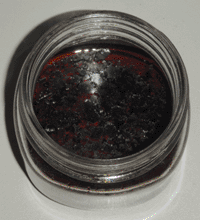
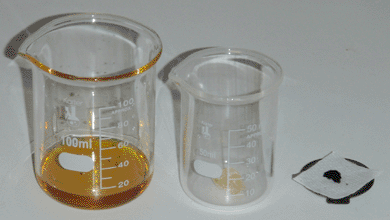
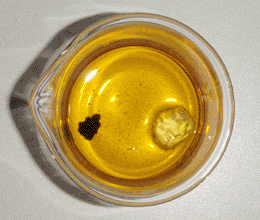
I then began heating the beaker on my electric hot plate; the rosin began to dissolve with only gentle heat, and as the temperature rose above 100°C the iron acetate flakes began to bubble. I then stirred the solution until the acetate was evenly distributed, and continued to raise the temperature further. The acetate slowly dissolved, turning the solution a deeper and deeper red-brown, but at 240°C the oil began to smoke so I removed it from the heat, roughly 30 minutes after heating began. Closer inspection revealed that there was still a significant sediment layer of undissolved iron acetate at the bottom of the beaker, so I cautiously reheated it at 140°C for an hour, then at 210°C for another two hours. At this point the sediment was only a tiny quantity of fine dust, so I decided to let the oil cool to room temperature. The finished product was nearly black, and tipping the beaker left a deep red-brown transparent film on the side. It had also become slightly more viscous than when I first inspected it, indicating that it had begun to polymerize. The stages of this process can be seen below.
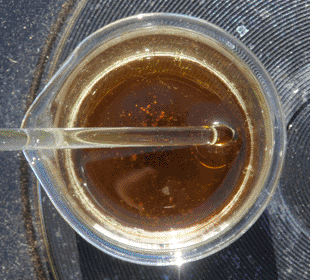
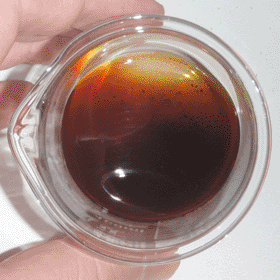
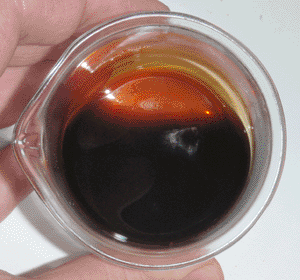
To test the drying properties of the iron resinate catalyst, I first painted a small amount of the oil on a piece of fir leftover from my wood stain experiments. I then added 10mL (for a 1/2 strength solution) of raw linseed oil to the beaker, stirred thoroughly, and painted another board. Finally, I added an additional 30mL (for a 1/5 strength solution) and painted a third board. I left the boards for an hour to allow the oil to soak in, then wiped off the excess with a rag. The next day (15 hours later) I inspected the boards, and only the first board had dried; the other two still left an oily residue when touched. I then set all three outside in the sun; after two hours they were all completely dry, and can be seen at the top of the page. The oil leaves an attractive satin finish, and causes interesting reflections between the wood grain and the light.
In general I'm pleased with the results, but some improvements could still be made to further reduce the complexity of the preparation, and to reduce the amount of unreacted sediment left in the product (some can be seen on the board painted with the most concentrated oil). Since I still have a large quantity of linseed oil left to experiment with, I intend to continue investigating the material, its properties, and its potential uses.